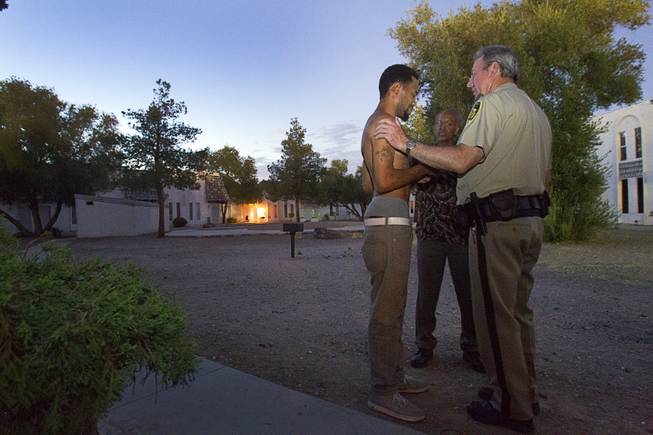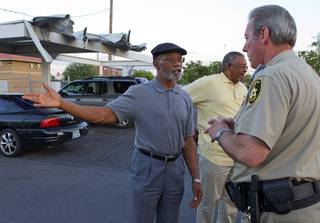
Metro Police Capt. Larry Burns talks with resident Drayton Barlow at the Desert Gardens Condominiums complex near Martin Luther King Jr. Boulevard and Bonanza Road Monday, Aug. 6, 2012. Barlow said he has no cold air in the upstairs of his unit and no cold water. He also has a newborn daughter and a 17-month-old son living in the apartment.
Thursday, Aug. 9, 2012 | 2 a.m.
Homicide numbers increasing in West Las Vegas
KSNV reports that homicides are increasing in West Las Vegas, Aug. 9.
Watch KSNV reporter Marie Mortera’s story about West Las Vegas neighborhood transformations at 4 p.m. and 6 p.m. today..
Desert Gardens
Related Stories
An emergency plan at a Bonanza Road day care calls for quick evacuation to a “safe spot” — a zone in the single-story building where owner Frances Thomas can huddle with her young flock.
But this is Las Vegas. Thomas isn’t overly worried about natural disasters. It’s what lies outside the brightly colored classroom that bothers her: fights, gang activity, people carrying guns.
The day care’s playground borders Desert Gardens, a complex of individually owned condominiums at 1720 W. Bonanza Road that residents and police alike say is riddled with problems.
“I have a lot of fear when I leave my building and when I walk into the building,” said Thomas, owner of Little Annie’s Day Care.
The neighborhood came on Metro Police’s radar late last year when officers patrolling the area began tracking gang members who seemed to be at every violent crime.
“We chased them around and found out coincidentally that most live here,” said Capt. Larry Burns of Metro’s Bolden Area Command, which includes the complex.
On Monday evening, Burns walked through the complex with fellow officers and local clergy he considers key community partners. The complex is the latest focus of their combined efforts to form a rapport with residents, address problems and ultimately reduce crime.
Before Burns even left the parking lot, resident Mary Grossman grabbed his arm, welcomed him back and rattled off issues plaguing her home.
Grossman’s air conditioning wasn’t working and hadn’t been for two weeks. Plus, a leak in her ceiling had turned into a hole.
Her complaints echoed those of many residents the group made contact with throughout the evening. Plumbing and electrical issues aside, though, safety fears permeated residents’ thoughts.
As Grossman said: “We’ve got your pimp daddies. We’ve got your drug dealers. We have your prostitutes.”
Previous Success
Several months ago, Burns said police were responding to about 120 calls per month at Desert Gardens, almost hidden from view by its dilapidated front entrance.
“If you didn’t know where you were going, you wouldn’t find it,” he said.
Police and community members’ now-frequent presence in Desert Gardens is an extension of the communitywide Safe Village Initiative, started in 2006 to curb crime and retaliatory gang violence in West Las Vegas. The initiative pooled police, community agencies and faith-based organizations to preach messages of peace and hope after violence. The group operated under the knowledge that if violence can be prevented in the first 24 hours after a shooting, retaliatory violence decreases by 90 percent.
A police department memo explaining the initiative described its need this way: “The reality is that police cannot arrest the problem away. Intervention and resources are needed.”
The Safe Village concept eventually spread to a public housing area consisting of Sherman Gardens, Sherman Gardens Annex and Villa Capri, Burns said. Located near Owens Avenue and J Street, the area suffered from similar, if not worse, problems that now affect Desert Gardens.
Several shootings per month in the 1,600-unit housing area weren’t uncommon several years ago, Burns said.
The Safe Village group entered the picture and began trying to reform the community — visit by visit, person by person.
“It’s not a program,” Burns said emphatically. “It’s a process, as I often say. We’ve been deep in this process going on two years now.”
If crime data are any indication, it worked. Gun-related calls and violence dropped by 89 percent in two years, he said. Overall, violent crime fell by 44 percent from 2010 to 2011. Perhaps most importantly, no one has been killed there in 18 months.
But the department isn’t resting on those statistics alone.
Police are experimenting with saturation patrols in a crime-prone neighborhood west of Sherman Gardens to answer a fundamental question: Which effort creates lasting change?
The saturation patrols will be in effect for 60 days, Burns said. After a normal police presence is restored, they will monitor the same neighborhood for another 60 days to see how crime compares.
“We know it has an effect on the short term,” Burns said. “My suspicion ... is that saturation does not in and of itself offer long-term solutions, and it’s long-term solutions we’re looking for.”
The apparent success of Safe Village already has caught the eye of law enforcement agencies across the country. Last year, the International Association of Chiefs of Police awarded Metro its Webber Seavey Award for Quality in Law Enforcement for the Safe Village efforts.
More recently, representatives from the Justice Department’s Community Oriented Policing Services (COPS) Office have interviewed police and community members about Safe Village, Burns said. The COPS Office is examining use-of-force incidents by Metro officers and is expected to release recommendations later this month.
Burns, who has been captain of Bolden Area Command for 18 months, called the implementation of Safe Village, which relies heavily on community help, a blessing in disguise given the department’s shrinking resources.
“As we look out two and four and five years from now, it’s bleak in terms of having more resources to put toward the crime-fighting effort,” he said.
Community volunteers, however, have grown. About 30 Safe Village participants meet every Monday afternoon to identify “hot spots” — areas experiencing crime increases — and develop new relationship-building strategies, Burns said. Community groups also meet with police leaders throughout the week.
Last week, Imam Mujahid Ramadan and several other men from the Nation of Islam detailed their recent efforts. They met groups of young men wandering without purpose, a scenario Ramadan said highlighted the need for more community resources.
“There’s no outlet for (the young men),” Ramadan said. “I think we have to start thinking long term. We’re talking generational at this point.”
Building Blocks
By 9 p.m. Monday in Desert Gardens, officers used their flashlights to illuminate the nearly pitch-dark complex. A few children zipped in and outside.
An eerie silence filled the air as Officer Jeffrey Willis walked toward buildings on the eastern side of the complex. He’s one of 10 community-oriented policing officers in Bolden Area Command who regularly visit Desert Gardens, often in plain clothes to more easily gain residents’ trust.
Residents living on the eastern side of the complex, however, have not been as receptive, he said.
“This is the side where we get the most calls for service,” Willis said.
Lakesha Johnson hopes that changes. The 35-year-old single mother recently called police when a teen beat up her 10-year-old daughter.
“Oh, I call often,” she told Tara Brosnahan, another community-oriented policing officer.
“Good,” Brosnahan replied.
Police and community leaders said that’s the relationship they’re trying to foster — open lines of communication.
Two weeks ago, officers and community partners threw a barbecue at Desert Gardens, viewing it as an icebreaker of sorts for the neighborhood. Afterward, Burns said a woman approached an officer and said her son was wanted for a burglary with a weapon. Concerned for his safety, she alerted officers so her son could be taken into custody without incident.
“It eased the burden on her mind and, frankly, eased the burden on our responsibility to get this individual in custody,” Burns said.
Police admit their success would be limited without key partners, some of whom can relate to residents on a more personal level.
Charles Webb, who mentors offenders and at-risk youths through the STAY Focused Program, shares with residents the wisdom he learned in prison. He credits his attempted robbery conviction with helping him find God.
“As an ex-convict, it’s hard enough,” he said. “We have to work harder than the average worker.”
It’s too early to tell how much of an impact the group is having on Desert Gardens. Regardless, police and community leaders said they’re here to stay. They already contacted the city and health department about some issues they noticed.
They know the solution lies among many.
“It’s a labor of love,” Burns said.
Even so, it’s safe to say they at least touched one person Monday evening — 9-year-old Shantwana Macon.
“I’ve never seen a girl cop before,” she shrieked, smiling broadly.


Join the Discussion:
Check this out for a full explanation of our conversion to the LiveFyre commenting system and instructions on how to sign up for an account.
Full comments policy